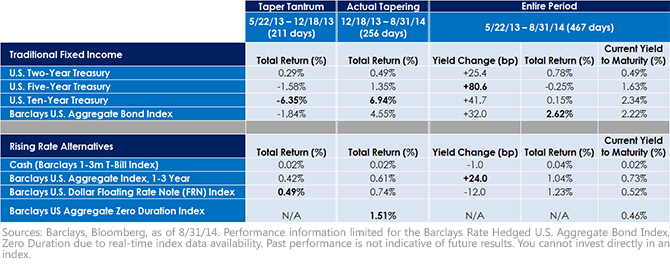Fed Policy: From Tapering to Tightening


 Shifting the focus of the analysis to the period of actual Fed tapering that began December 18, 2013, we see that traditional fixed income performed well as longer-term rates fell in 2014. Curiously, rising-rate strategies provided very similar returns to those experienced during the “taper tantrum.” This can largely be explained by the fairly muted rise in interest rates at the short end of the yield curve. During both periods, income potential was the primary driver of returns. As a result, total returns remained constrained but positive.
Tapering vs. Tightening
In our view, returns experienced during the “taper tantrum” represent a possible best-case scenario for traditional rising-rate strategies. Over that time, longer-term interest rates rose while short-term rates remained contained, helping to insulate investors from losses that reduced interest rate risk. When the market becomes more concerned about the timing of the first Fed rate hike, this portion of the yield curve, where investors formerly sought safety, could come under considerable pressure. At current income levels, the margin for error remains extremely low.
As an alternate approach, we also illustrate how a duration-hedged approach performed since the Fed began tapering. In this strategy, Barclays Rate Hedged U.S. Aggregate Zero Duration Index is exactly the same as the traditional Barclays U.S. Aggregate Index, but a second-step adjustment seeks to hedge interest rate risk to zero. As a result, investors were able to maintain traditional bond exposures while reducing interest rate risk. With hindsight, we know that hedging interest rate risk detracted from returns as rates fell during Fed tapering. However, when compared with traditional rising rate alternatives, this approach, demonstrated by the Barclays Rate Hedged U.S. Aggregate Zero Duration Index generated significantly better performance. In subsequent blog posts in this series, we will discuss similar approaches to managing interest rate risk in greater detail.
Ultimately, the timing of changes in Fed policy remains far from certain. However, with Fed tapering largely a foregone conclusion, investors should begin to prepare their portfolios for the next move in Fed policy.
Shifting the focus of the analysis to the period of actual Fed tapering that began December 18, 2013, we see that traditional fixed income performed well as longer-term rates fell in 2014. Curiously, rising-rate strategies provided very similar returns to those experienced during the “taper tantrum.” This can largely be explained by the fairly muted rise in interest rates at the short end of the yield curve. During both periods, income potential was the primary driver of returns. As a result, total returns remained constrained but positive.
Tapering vs. Tightening
In our view, returns experienced during the “taper tantrum” represent a possible best-case scenario for traditional rising-rate strategies. Over that time, longer-term interest rates rose while short-term rates remained contained, helping to insulate investors from losses that reduced interest rate risk. When the market becomes more concerned about the timing of the first Fed rate hike, this portion of the yield curve, where investors formerly sought safety, could come under considerable pressure. At current income levels, the margin for error remains extremely low.
As an alternate approach, we also illustrate how a duration-hedged approach performed since the Fed began tapering. In this strategy, Barclays Rate Hedged U.S. Aggregate Zero Duration Index is exactly the same as the traditional Barclays U.S. Aggregate Index, but a second-step adjustment seeks to hedge interest rate risk to zero. As a result, investors were able to maintain traditional bond exposures while reducing interest rate risk. With hindsight, we know that hedging interest rate risk detracted from returns as rates fell during Fed tapering. However, when compared with traditional rising rate alternatives, this approach, demonstrated by the Barclays Rate Hedged U.S. Aggregate Zero Duration Index generated significantly better performance. In subsequent blog posts in this series, we will discuss similar approaches to managing interest rate risk in greater detail.
Ultimately, the timing of changes in Fed policy remains far from certain. However, with Fed tapering largely a foregone conclusion, investors should begin to prepare their portfolios for the next move in Fed policy. Important Risks Related to this Article
Fixed income investments are subject to interest rate risk; their value will normally decline as interest rates rise. In addition, when interest rates fall, income may decline. Fixed income investments are also subject to credit risk, the risk that the issuer of a bond will fail to pay interest and principal in a timely manner or that negative perceptions of the issuer’s ability to make such payments will cause the price of that bond to decline.

Rick Harper serves as the Chief Investment Officer, Fixed Income and Model Portfolios at WisdomTree Asset Management, where he oversees the firm’s suite of fixed income and currency exchange-traded funds. He is also a voting member of the WisdomTree Model Portfolio Investment Committee and takes a leading role in the management and oversight of the fixed income model allocations. He plays an active role in risk management and oversight within the firm.
Rick has over 29 years investment experience in strategy and portfolio management positions at prominent investment firms. Prior to joining WisdomTree in 2007, Rick held senior level strategist roles with RBC Dain Rauscher, Bank One Capital Markets, ETF Advisors, and Nuveen Investments. At ETF Advisors, he was the portfolio manager and developer of some of the first fixed income exchange-traded funds. His research has been featured in leading periodicals including the Journal of Portfolio Management and the Journal of Indexes. He graduated from Emory University and earned his MBA at Indiana University.

